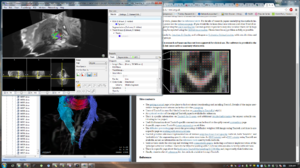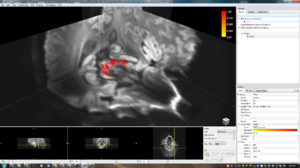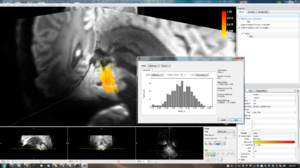I'm starting this thread to show everyone what I'm doing when it comes to objective diagnostics of tinnitus and hearing damage through diffusion tensor weighted magnetic resonance imaging (DTI-MRI).
An MRI in itself works by means of nuclear magnetic resonance (NMR) which in itself is very difficult to explain. My second year Bsc. practical project and research was performed with an NMR device and I still haven't wrapped my head around the imaging aspects of it completely. All the terms here are explained in detail on wikipedia for anyone interested, but in simple terms an MRI measures how fast an atom within the subject returns to rest after being magnetized. Returning to rest can only happen if something provides the energy, and since liquid has more energy than dry skin a contrast will be created between them. For this reason the MRI only has a grayscale.
DTI uses an effect known as diffusion which occurs in liquids, in this case of water, to record in which direction the water flows. Through this means we can map the individual white matter strands in the human brain. While mapping something like the auditory pathway we can also measure the scalar (amount) of diffusion in whatever the direction is. If this amount, or diffusivity, is suddenly very small somewhere, meaning that water diffusion is impeded heavily, we could determine whether the white matter has incurred damage.
An alternate use of this technique is to examine how the brain is wired up in different individuals with different conditions i.e autism, after prolonged substance abuse, tinnitus, hearing damage, and so on.
This article explains the mechanics of DTI for whoever wants some world class excellent reading with their morning tea;
http://www.ncbi.nlm.nih.gov/pmc/articles/PMC2041910/
After having my brain scanned by an ultra high field research MRI I've begun busy researching the topic as it offers me with data far more accurate than what I could have achieved with my modified ABR in my home lab. This might be the understatement of the year but I'm obviously not equipped to match millions worth of high tech experimental research MRI inside a large bunker with active shielding... yet... but soon..
At the moment I'm still struggling a bit with some of the machine specific geometry and reading some tutorials on the software packs. Until now here is an impression of what I've been doing, below is my own brain. The first image shows the research team's tractography below and my failed one above, the second image shows a good one including color coding according to diffusivity in my dorsal cochlear nucleus (DCN).



DTI, or for that matter 7 Tesla MRI's are not currently used in medicine because the protocols for it are still being developed by the large universities, and it's currently still far more expensive than regular 3 Tesla MRI's. I'm unsure as to the current level of education a neurology major contains on tractography (mapping tracks in the brain) but I'll have a look at the courses to see if it's something worth dropping in on from time to time, or perhaps do a minor in.
I'll keep posting here as I progress through findings, and answer questions. I hope to spark a little interest in everyone here, give us another place to start when it comes to tinnitus research, and perhaps point out where else should can keep an eye open (DTI related research) so that it doesn't slip through our net.
An MRI in itself works by means of nuclear magnetic resonance (NMR) which in itself is very difficult to explain. My second year Bsc. practical project and research was performed with an NMR device and I still haven't wrapped my head around the imaging aspects of it completely. All the terms here are explained in detail on wikipedia for anyone interested, but in simple terms an MRI measures how fast an atom within the subject returns to rest after being magnetized. Returning to rest can only happen if something provides the energy, and since liquid has more energy than dry skin a contrast will be created between them. For this reason the MRI only has a grayscale.
DTI uses an effect known as diffusion which occurs in liquids, in this case of water, to record in which direction the water flows. Through this means we can map the individual white matter strands in the human brain. While mapping something like the auditory pathway we can also measure the scalar (amount) of diffusion in whatever the direction is. If this amount, or diffusivity, is suddenly very small somewhere, meaning that water diffusion is impeded heavily, we could determine whether the white matter has incurred damage.
An alternate use of this technique is to examine how the brain is wired up in different individuals with different conditions i.e autism, after prolonged substance abuse, tinnitus, hearing damage, and so on.
This article explains the mechanics of DTI for whoever wants some world class excellent reading with their morning tea;
http://www.ncbi.nlm.nih.gov/pmc/articles/PMC2041910/
After having my brain scanned by an ultra high field research MRI I've begun busy researching the topic as it offers me with data far more accurate than what I could have achieved with my modified ABR in my home lab. This might be the understatement of the year but I'm obviously not equipped to match millions worth of high tech experimental research MRI inside a large bunker with active shielding... yet... but soon..

At the moment I'm still struggling a bit with some of the machine specific geometry and reading some tutorials on the software packs. Until now here is an impression of what I've been doing, below is my own brain. The first image shows the research team's tractography below and my failed one above, the second image shows a good one including color coding according to diffusivity in my dorsal cochlear nucleus (DCN).



DTI, or for that matter 7 Tesla MRI's are not currently used in medicine because the protocols for it are still being developed by the large universities, and it's currently still far more expensive than regular 3 Tesla MRI's. I'm unsure as to the current level of education a neurology major contains on tractography (mapping tracks in the brain) but I'll have a look at the courses to see if it's something worth dropping in on from time to time, or perhaps do a minor in.
I'll keep posting here as I progress through findings, and answer questions. I hope to spark a little interest in everyone here, give us another place to start when it comes to tinnitus research, and perhaps point out where else should can keep an eye open (DTI related research) so that it doesn't slip through our net.
